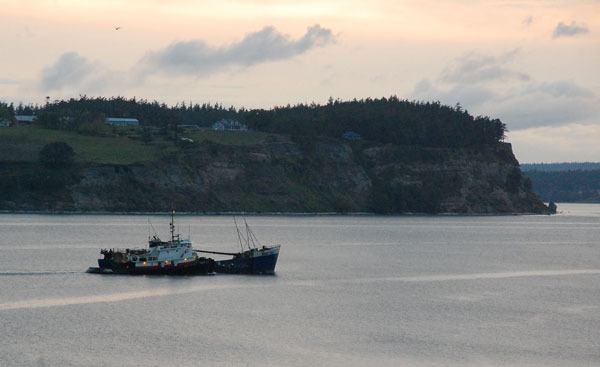As planned, the fishing vessel Deep Sea was towed out of Penn Cove Wednesday and taken to a dry dock in Ballard.
The ship departed promptly at 5 a.m. under tow by the tugboat Taurus. Traveling at about six knots, they arrived at the Chittenden Locks in Seattle shortly after noon.
The 128-foot crab boat was then delivered to Stabbert Yacht and Ship dry dock for dismantling.
The Deep Sea arrived in Penn Cove by tow in December. The vessel sat at anchor just outside Penn Cove Shellfish’s mussel rafts for the next four months until it caught fire and then sank, May 13.
The vessel spent three weeks on the bottom before it was raised this past Sunday. More than 5,000 gallons of diesel fuel was recovered from the ship and the surface, prompting the closure of shellfish harvesting.
On Tuesday, the state Department of Health opened areas north of Mueller Park and some recreational beaches along the south shore of Penn Cove. Commercial harvesting at the farm remained closed.
Jerrod Davis, director of the office for shellfish and water protection, confirmed that additional testing for taste and smell was conducted Friday but the results were not available by press time.
Toxicity testing has already been completed.
It is possible that additional areas will be opened following the latest round of taste and smell testing, but Davis said he could not speculate on how much of the fishery will be opened.
“We really can’t say,” Davis said. “It would be great to open all of Penn Cove but it really depends on the results. We want to make sure the shellfish are safe to eat.”
As for the Deep Sea, the state Department of Natural Resources announced Thursday that it will be broken up and disposed of once an investigation into the cause of the fire has been completed.
The agency has asked the King County Sheriff’s Office fire investigation unit for assistance in determining the cause of the blaze.
According to a news release, the final cost of disposal has not yet been determined. The vessel was filled with up to 40,000 pounds of mud and silt when it was raised and all of it will need to be removed before an assessment of toxic substances, such as asbestos, can be performed.
Officials with the department’s Derelict Vessel Program have said asbestos removal can be one of the most expensive parts of disposal. They have estimated the total cost at no more than $400,000.
So far, the various state agencies that participated in the Deep Sea crisis have spent about $1.5 million managing pollution, diving operations and raising the crippled vessel.
According to U.S. Coast Guard Chief Darryl Harvey of the incident management division at Sector Puget Sound in Seattle, most of that money is being reimbursed through the federal Oil Spill Liability Trust Fund, a pot of money managed by the agency’s National Pollution Funds Center.
Including the state’s reimbursement, Harvey estimated the Coast Guard’s total bill at $2.7 million. That does not include the cost of disposal or the federal agency’s indirect expenses, which he said are about $300,000.



